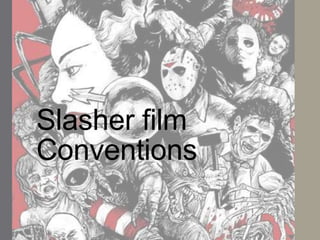Med
- 2. Final Girl ŌĆó A common convention in slasher film, the girl represents the dominant male ideology on what a female should be in society. The final girl is the only survivor in most slasher films, most of the friends are killed. The final girl is pure whilst her group of friends are promiscuous, drug taking troubled teens. ŌĆó She is not made out to be as feminine as the other girls, and she is a virgin, she is pure which is why she doesnŌĆÖt die.
- 4. The Monster/Killer This is the antagonist of the film. His identity is often concealed and is shown to be not human but more of a beast or a monster. They are often mute, powerful as they are able to withstand stabbings and high falls. The monster is very strong and tall to making it seem almost impossible to kill. They tend to have handheld weapons such as axes, knifes hammers etc.
- 6. Group of friends ŌĆó Another trope in slasher films. Everyone in the group besides the final girl will die, those in the group are not as ŌĆ£pureŌĆØ as the final girl. They tend to be young and attractive, they can be seen as being punished for their vices such as drugs and promiscuity. They are usually killed during or after sexual activity.
- 8. Locations ŌĆó Common locations include the woods, a school, abandoned hospital, graveyards, alleyways etc. These locations are usually isolated, in urban areas, making the film setting feel more close to home. This makes the audience feel uneasy as the fear hits more close to home.
- 10. Benefactor ŌĆó Usually an older character who guides the final girl by giving advice to kill the monster. They are usually in a position of power such as police, doctor, professor etc. they usually show up when the monster has killed most of the group, saving the final girl.
- 12. German Expressionism ŌĆó Was a major cultural movement that began in Germany around the first world war. The movement represents Germany at the time, very dark. It consisted of using lights, abstract shapes and shadows in a bizarre way, creating another reality which looked nothing like real life. It was used to represent the minds of the characters and what it happening to them. The movement was short lived, but its influence still lives. Many films manipulate shadows and light in order for mise en scene to explain the narrative in a creative way. ŌĆó The lighting/ shadows used in these German expressionism films have inspired the horror genre. The shadows and lighting help to create tensions in these types of films and they amplify the killers presence.
- 14. Film noir ŌĆó Film noir is a style of film made during the 1950s; film noir was dark crime based thriller type film which revolved around a detective solving a mysterious crime. At first it the detective is solving a crime that seems small then it grows into something big. Film noir films are based on paranoia and they were popular in the time when paranoia was prevalent in American society.















